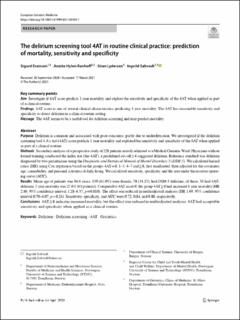| dc.description.abstract | Purpose Delirium is common and associated with poor outcomes, partly due to underdetection. We investigated if the delirium screening tool 4 A’s test (4AT) score predicts 1 year mortality and explored the sensitivity and specifcity of the 4AT when applied as part of a clinical routine. Methods Secondary analyses of a prospective study of 228 patients acutely admitted to a Medical Geriatric Ward. Physicians without formal training conducted the index test (the 4AT); a predefned cut-of≥4 suggested delirium. Reference standard was delirium diagnosed by two geriatricians using the Diagnostic and Statistical Manual of Mental Disorders 5 (DSM-5). We calculated hazard ratios (HR) using Cox regression based on the groups 4AT=0, 1–3, 4–7 and≥8, frst unadjusted, then adjusted for the covariates age, comorbidity, and personal activities of daily living. We calculated sensitivity, specifcity, and the area under the receiver operating curve (AUC). Results Mean age of patients was 86.6 years, 139 (61.0%) were female, 78 (34.2%) had DSM-5 delirium; of these, 56 had 4ATdelirium. 1 year mortality was 27.6% (63 patients). Compared to 4AT score 0, the group 4AT≥8 had increased 1 year mortality (HR 2.86, 95% confdence interval 1.28–6.37, p=0.010). The efect was reduced in multiadjusted analyses (HR 1.69, 95% confidence interval 0.70–4.07, p=0.24). Sensitivity, specifcity, and AUC were 0.72, 0.84, and 0.88, respectively. Conclusions 4AT≥8 indicates increased mortality, but the efect was reduced in multiadjusted analyses. 4AT had acceptable sensitivity and specifcity when applied as a clinical routine. | en_US |

